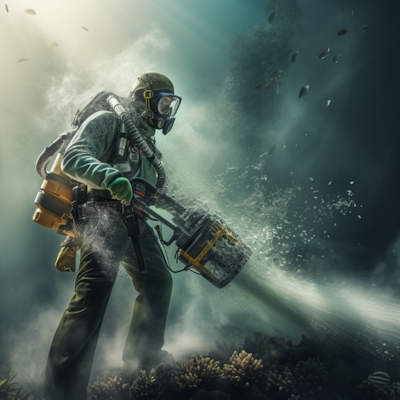The ship prop will fall prey to the inevitable marine buildup of barnacles, algae, and other oceanic detritus. Keeping a ship’s prop clean not only ensures optimal performance but also safeguards the vessel’s overall health. Let’s delve into the nitty-gritty of prop cleaning, the options available, and the processes involved.
Brushing the Brine Away: Manual Cleaning
The most traditional method of propeller cleaning involves divers manually scrubbing the propeller using brushes and scrapers.
Process: A team of professional divers descends to the propeller, armed with an arsenal of tools. They carefully scrape off marine growth, taking care not to damage the propeller’s surface.
Pros and Cons: Manual cleaning is a reliable method that can effectively remove most types of buildup. However, it is labor-intensive, and the effectiveness can depend heavily on the skill and experience of the divers.
Harnessing the Power of Pressure: High-Pressure Water Cleaning
High-pressure water cleaning involves using a specialized underwater jet to blast away marine growth.
Process: Divers use a high-pressure water jet, which releases a strong stream of water that dislodges marine growth from the propeller’s surface.
Pros and Cons: This method is faster and often more effective than manual cleaning. However, it requires specialized equipment and skilled divers. Also, care must be taken to ensure the pressure is not so high as to damage the propeller.
The Pulse of Innovation: Robotic Cleaning
The latest innovation in propeller cleaning involves the use of remotely operated vehicles (ROVs) or robotic divers.
Process: An ROV equipped with cleaning tools and cameras is remotely navigated to the propeller. The operator can then use the ROV to clean the propeller, guided by the live video feed.
Pros and Cons: Robotic cleaning can be highly effective and eliminates the need for human divers, enhancing safety. It also allows for precision cleaning. However, this method requires a significant investment in technology and training.
Chemical Cleaning: Dissolving the Debris
Chemical cleaning involves the use of marine-safe solvents to dissolve marine growth.
Process: A cleaning solution is applied to the propeller, either by divers or by using an ROV. The solution breaks down the marine growth, which can then be easily removed.
Pros and Cons: Chemical cleaning can be useful for stubborn growth. However, it’s essential to use marine-safe products to prevent environmental harm. Also, this method often needs to be used in conjunction with another cleaning method for full effectiveness.
Preserving the Pulse: Regular Maintenance
Whatever cleaning method you choose, it’s important to remember that regular maintenance is key. Regular inspections and cleaning can prevent excessive buildup, maintain the propeller’s performance, and reduce the risk of damage.
Like the heart in our chests, the propeller is the pulse of our vessels. Keeping it clean and in optimal condition is not just a matter of maintenance, but a testament to our respect for the sea and the vessels that navigate its vast expanse.
